
The U.S. Census Bureau released new data in September on income, poverty, education, and health insurance coverage in 2019. These metrics paint a picture of the social and economic circumstances across America in the final year of a historically long period of economic growth. For years to come, they will serve as a baseline to measure many of the coronavirus recession’s short- and long-term effects.
Here’s what stands out from the 2019 estimates of income and poverty in Tennessee.
Key Takeaways
- Tennessee saw large improvements in median household income and the official poverty rate last year, but both metrics continue to trail the national average.
- Median household incomes trended upward over the last decade for black, white, and Hispanic Tennesseans, but differences in their purchasing power also grew.
- Meanwhile, racial and ethnic differences in the poverty rate varied over the last decade but ultimately shrank.
Income and Poverty in Tennessee
Tennessee saw large improvements in income and poverty in 2019. Median household income in the state reached $56,000 last year, meaning half of households had less income and half had more (Figure 1). (1) After adjusting for inflation, that is a 5% increase from the year before (Figure 2). (2) (1) Meanwhile, the official poverty rate fell to 13.9% — down 1.4 points from 2018 — and child poverty fell 2.6 points to 16.8% (Figures 3 and 4). (1) These trends unfolded as earnings grew at nearly every level of education over the last decade — especially among Tennesseans with the least education. See Table A1 in the Appendix for the 2018–2019 data.
Figure 1
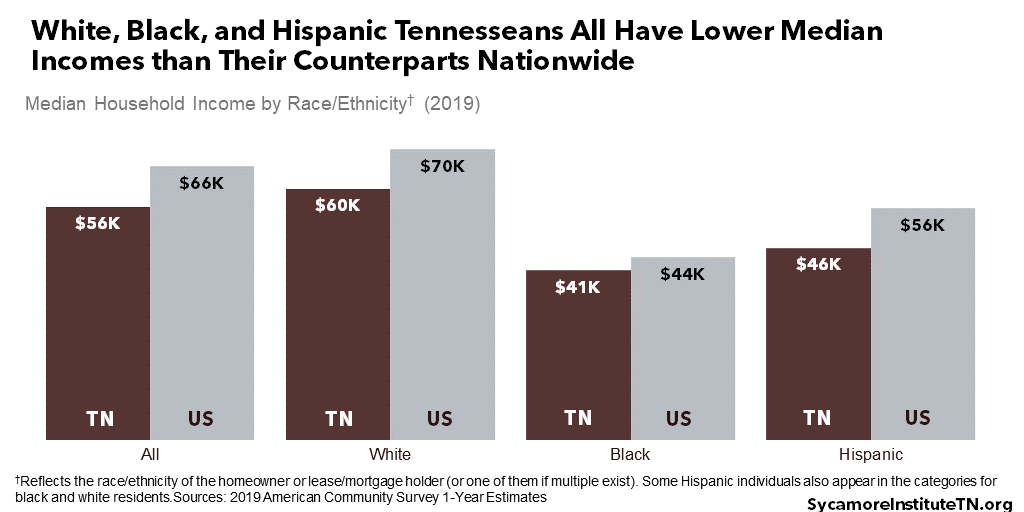
Figure 2
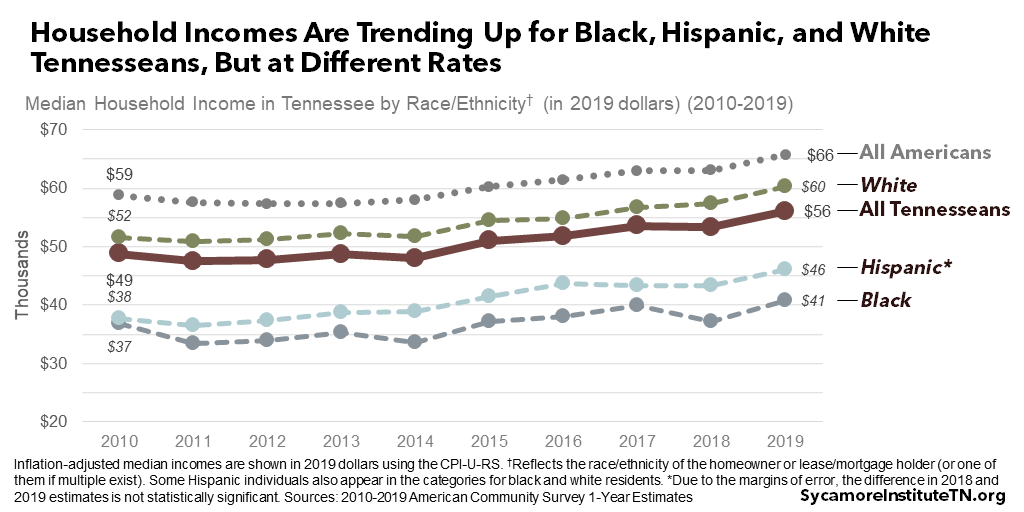
Figure 3
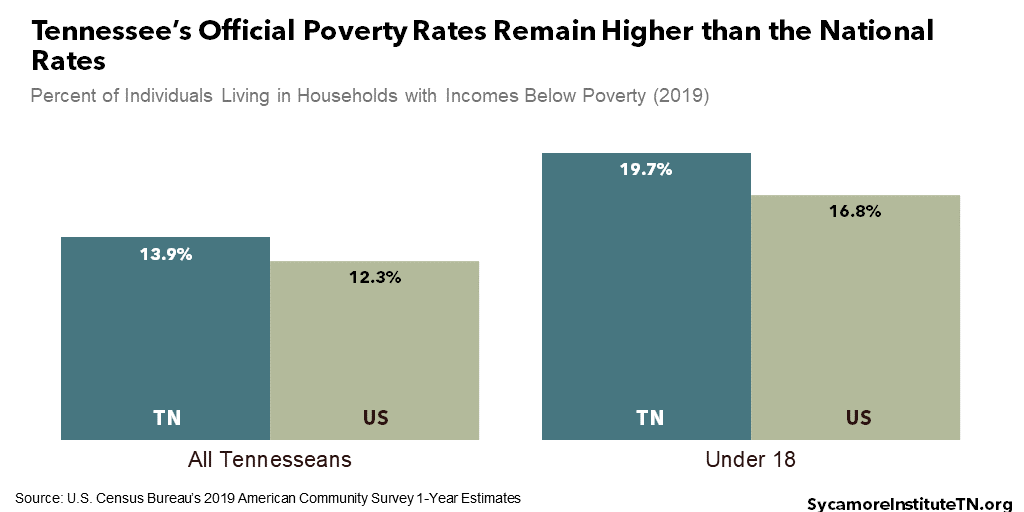
Figure 4
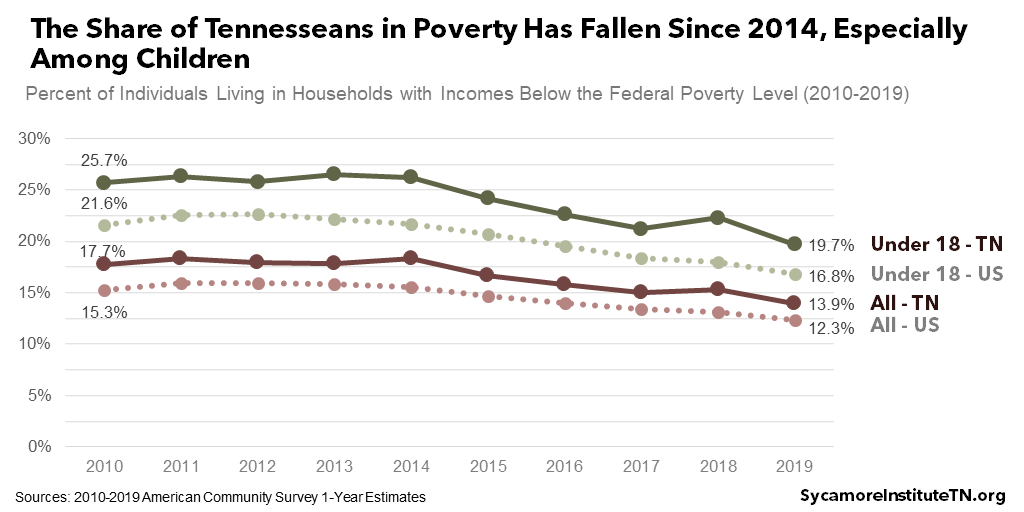
Demographic Variation
Tennessee’s poverty rate and median income vary across race, ethnicity, education level, employment, and household type. In 2019, Hispanic Tennesseans, adults without a high school diploma, and unemployed adults had the highest rates of poverty, while white residents, college graduates, and full-time workers had the lowest (Figure 5). In terms of household type, poverty rates were lowest for married couples without children and highest for female-headed, non-married households with children. (Figure 6). (1)
Racial and ethnic differences in the poverty rate varied over the last decade but ultimately shrank (Figure 7). (1) In 2010, the poverty rate among Hispanic Tennesseans was 19 percentage points higher than for whites and 5 points higher than that of black residents. By 2019, those gaps had narrowed to 12 and 2 points, respectively. For black Tennesseans, the difference from white Tennesseans shrank from 14 points to 10 points.
Median household incomes trended upward over the last decade for black, white, and Hispanic Tennesseans, but differences in their purchasing power also grew (Figure 2). (1) (2) Adjusted for inflation, Tennesseans’ median household income grew most quickly over the last decade among Hispanics (up 23%), followed by white (up 17%) and black residents (up 11%). In dollar terms, the difference between white and Hispanic incomes grew by about $200 while the gap between white and black incomes rose by $4,700.
Figure 5
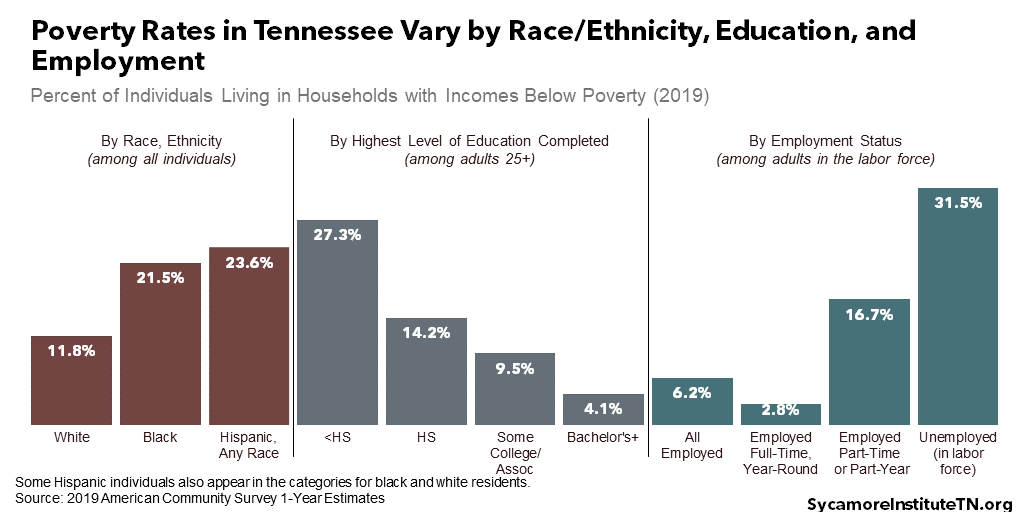
Figure 6
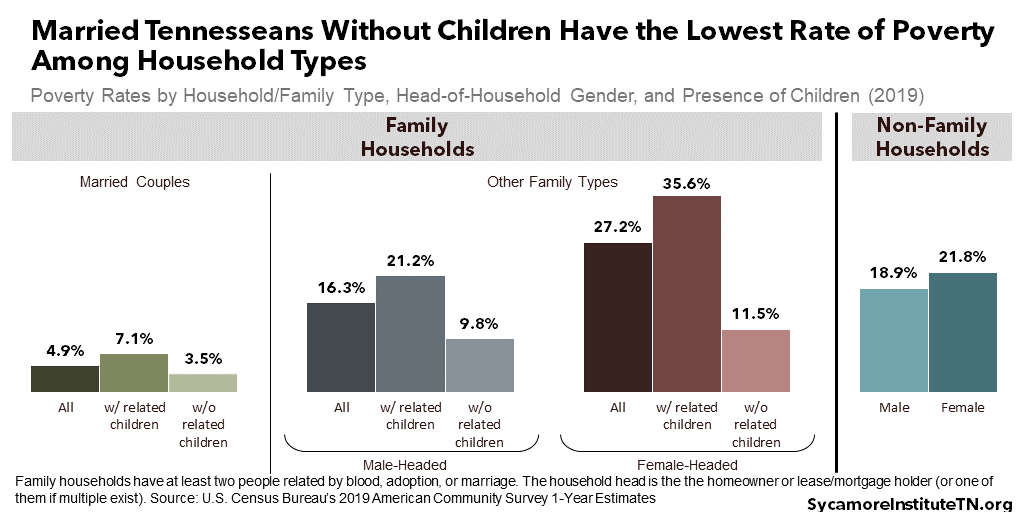
Figure 7
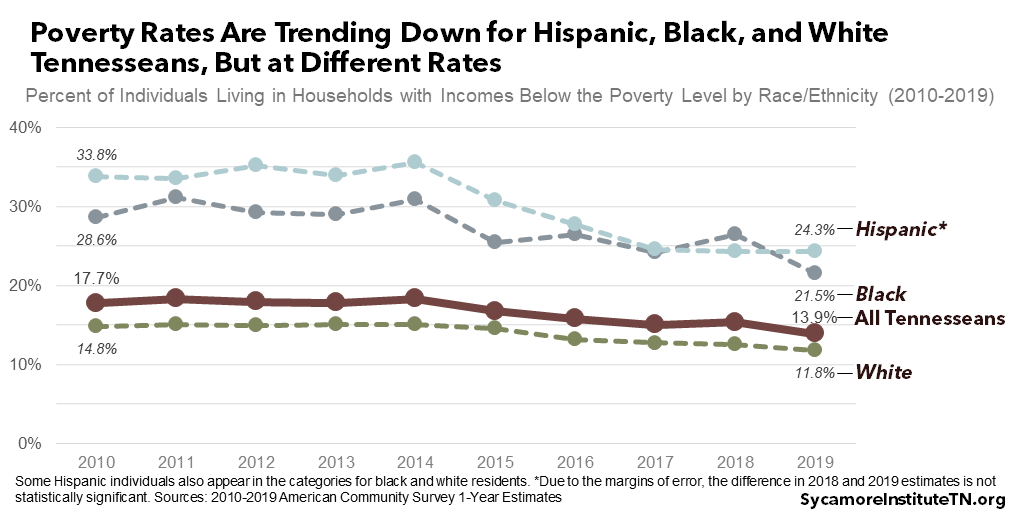
Geographic Variation
Income and poverty rates in Tennessee also vary by geography. The Census Bureau’s September data release includes 2019 estimates for counties with populations above 65,000. Among the 20 Tennessee counties with available data (1):
- Median Household Income — Median household income ranged from nearly $116,000 in Williamson County to about $45,000 in Greene County (Figure 8). Seven counties experienced a statistically significant increase last year. Due to the margins of error, the difference in all other 2018 and 2019 estimates is not statistically significant.
- Poverty Rate — The official poverty rate varied from 4.5% in Williamson County to 18.3% in Madison County (Figure 9). From 2018 to 2019, statistically significant improvements occurred in Davidson (down 3 points), Maury (down 4 points), and Shelby Counties (down 5 points).
- Child Poverty — Meanwhile, the poverty rate among residents younger than 18 ranged from 4.4% in Williamson County to 22.5% in Madison County (Figure 10). Statistically significant changes occurred in Davidson (down 10 points), Putnam (up 15 points), Shelby (down 9 points), and Williamson Counties (up 3 points).
See Table A1 in the Appendix for county-specific data for 2018 and 2019 and this link for a detailed breakdown for Shelby County.
Figure 8
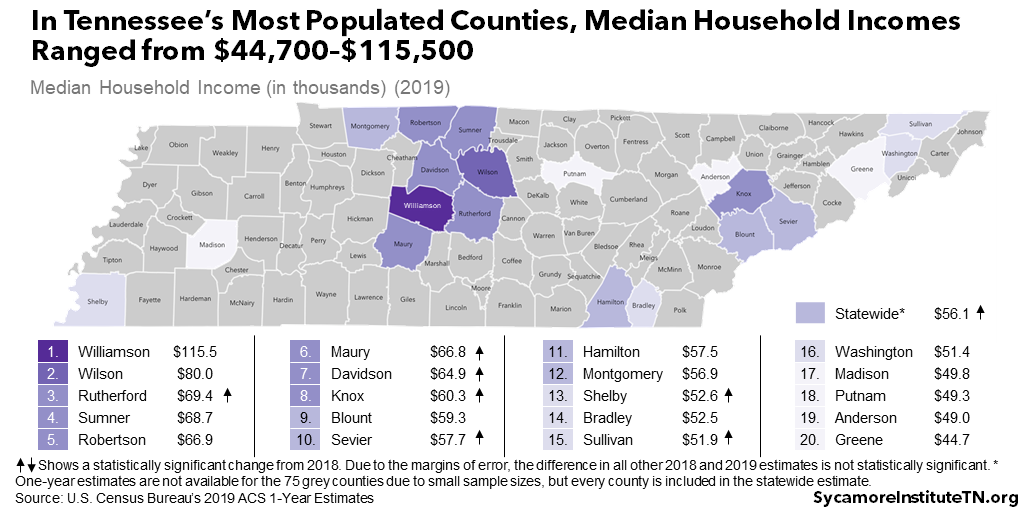
Figure 9
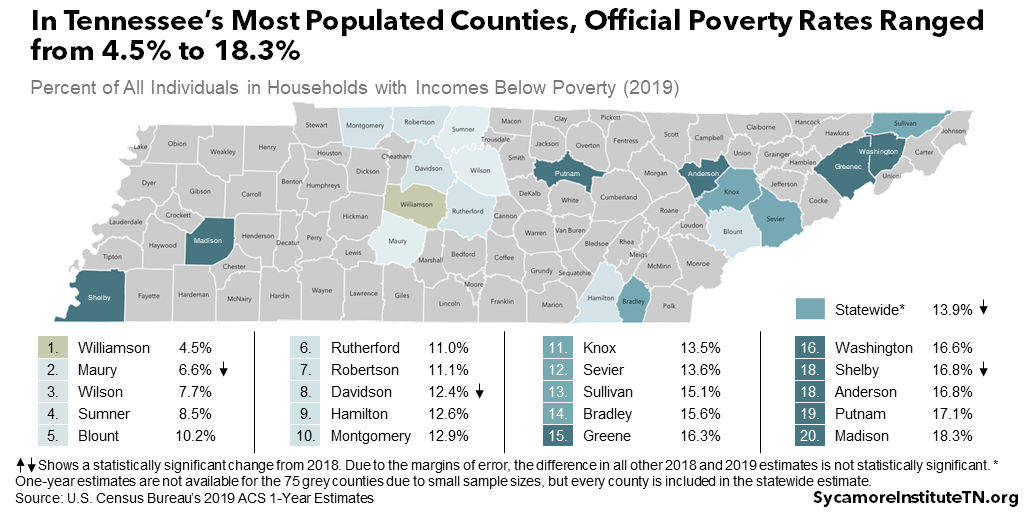
Figure 10
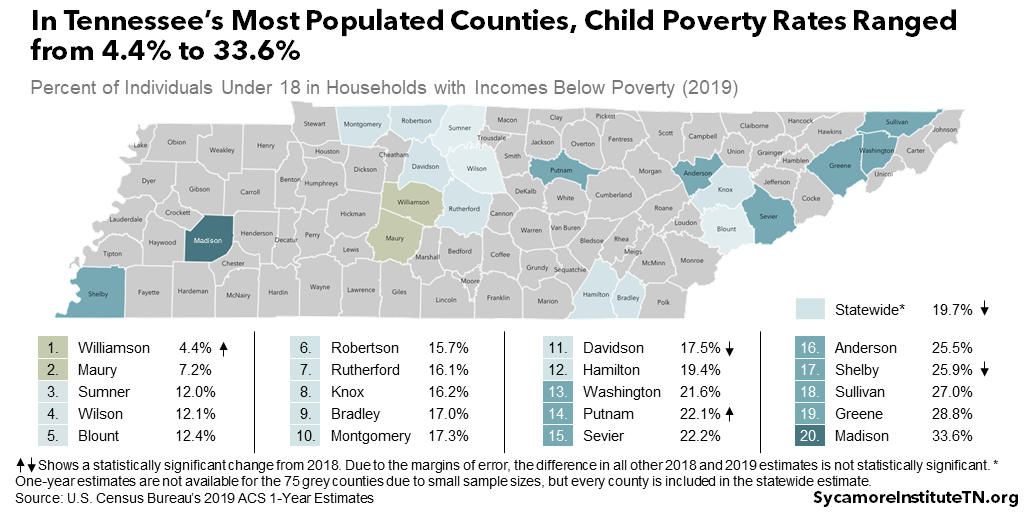
References
Click to Open/Close
- U.S. Census Bureau. 2010-2019 American Community Survey 1-Year Estimates. [Online] September 17, 2020. Accessed from http://data.census.gov.
- U.S. Bureau of Labor Statistics. Consumer Price Index: R-CPI-U-RS. [Online] [Cited: September 14, 2020.] Accessed from https://www.bls.gov/cpi/research-series/r-cpi-u-rs-home.htm.
* Due to the margins of error, the difference in some 2018 and 2019 estimates is not statistically significant. The Census Bureau’s American Community Survey generates estimates based on a sample of the total population. The margin of error measures the likely range of the true value if every person were surveyed. When the error margins for two values overlap, the difference may simply be due to sampling or estimation issues. To learn more about the importance of samples, read our tips for interpreting statistics.
















